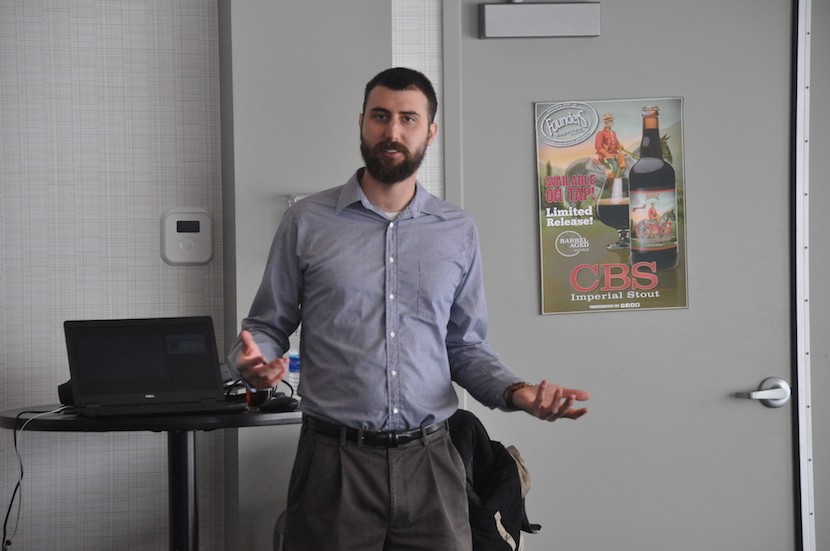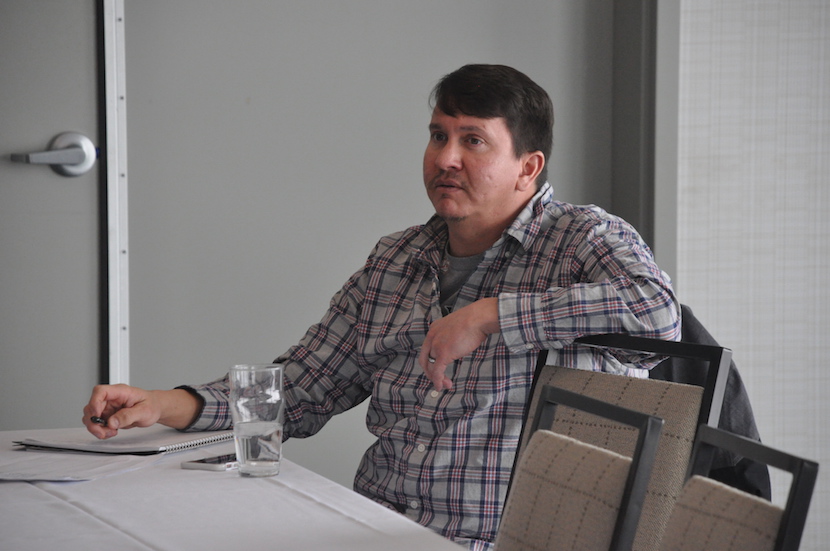
Treacherous roads on the second snow day in a row were not enough to keep Band biologists Carl Klimah and Kelly Applegate and a small group of hearty harvesters from discussing the latest data on the Mille Lacs Lake ogaa (walleye) population at Eddy's Resort on Tuesday, March 6.
Those in attendance enjoyed a clear and thorough presentation covering survey results, population projections, fisheries committee updates, and spring harvest information. Carl and Kelly took questions and received feedback to bring to DNR Commissioner Bradley Harrington and the Great Lakes Fish and Wildlife Commission.
Carl started with a review of walleye population estimates, which are based primarily on Minnesota DNR gillnet surveys. Each fall for several decades, the state DNR has placed 52 nets at specific locations around the lake.
In recent years, those surveys have indicated a historically low population of ogaa, which has resulted in small quotas for state anglers as well as tribal netters and spearers.
Although the population appears to be rebounding, the projections are based mainly on the success of one year-class of walleyes, which hatched in 2013. The year classes before and after have started out fine but have not survived into adulthood in large numbers.
Many factors may be playing a role, including improved water clarity, invasive species like zebra mussels and spiny water fleas, and competition from other fish species like northern pike and smallmouth bass. High rates of cannibalism of small ogaa by larger ogaa indicate a lack of other bait fish in the lake.
As zebra mussels have expanded, Carl explained, they have reduced the lake's zooplankton — tiny organisms that feed growing walleyes as well as other fish.
One potentially positive development was a large perch hatch in 2017. The last large perch hatch was in 2013, the last time a large number of walleyes survived to adulthood.
Those 2013 fish are now 16 to 20 inches long — the perfect size for catching and eating — so it's imperative to prevent overharvest and preserve enough spawning fish to create future generations of walleyes.
"Everything has to come together just right for a good year class," Carl said. That's more true today than ever before, with disruptions caused by invasive species, climate change, and other man-made disruptions to nature's balance.
Committee update
Biologists from the Mille Lacs Band, the State of Minnesota, and the seven other Ojibwe bands with 1837 Treaty rights make up the 1837 Ceded Territory Fisheries Committee (also known as the “FTC”). At their February 6 meeting in Brainerd they did not reach a consensus on the allowable harvest or quota level, Carl said. The two sides are now engaged in further talks, and the State has announced a catch-and-release season for 2018. In August of 2015, the Minnesota DNR closed the lake to walleye angling after anglers reached their annual quota. The following year, when anglers once again reached their quota, Governor Mark Dayton ordered that the lake remain open. The 2016 season was catch-and-release only, but anglers still reached their quota due to "hooking mortality," which refers to the death of fish after release. Studies show that five to 10 percent of released fish will die.
In 2017, pursuant to an agreement with the Bands, the State remained within its walleye mortality caps by closing fishing during a few weeks in the hot summer months and making other regulatory changes. For 2018, the State again is obligated to stay within its angling harvest caps.
The eight Ojibwe bands have never exceeded their quota. They also count every fish harvested by net or spear, while the state angling harvest is estimated using creel surveys.
Resort owners, fishing guides, and anglers reported good catch rates in recent years, leading some to the claim that walleye population estimates are very inaccurate, and that the population is much higher than the DNR reports.
However, a strong bite can also indicate a lack of forage that makes fish hungrier. In addition, two independent reviews confirm the validity of the population estimates agreed upon by Tribal, GLIFWC, and State biologists. Reports are that the State’s ice fishing catch rates declined this winter, and the walleye are fat, leading to some optimism that the forage base might be doing better.
The Bands, GLIFWC, and the State will conduct a mark-recapture population study this year. This will result in a new population estimate that is more accurate than estimates from computer models. The state DNR also has undertaken a fish tagging study to better estimate the number of naturally produced walleye fry in the lake. The agency has also conducted a hooking mortality study and a study of what predator fish eat.
In 2018, the Mille Lacs Band, GLIFWC, the Fond du Lac Band, and the U.S. Fish and Wildlife Service will begin an ogaa tracking study to attempt to better understand the increase in walleye cannibalism.
Know Your Government: DNR
The Department of Natural Resources (DNR) develops and implements wildlife, fish, and forestry improvement activities and regulates hunting, fishing, and gathering on and off the reservation. It also provides many other services, including conservation enforcement, environmental protection, natural resource permits, historical and cultural preservation, and tribal enrollment.
The Commissioner of Natural Resources is Bradley Harrington. Commissioner Harrington has stated that an Anishinaabe view of natural resources includes a recognition that all things come from the Creator and are gifts from the Manidoog (Spirits).
"What the Anishinaabe see as natural resources are all the things the Manidoo have given them, including ceremonies, traditions, and the language," says Commissioner Harrington.
During his time in office he has language revitalization and cultural preservation while maintaining a strong emphasis on habitat, fish and wildlife, and conservation.
The Department operates a Wildlife Program to enhance and protect habitat and a Fisheries Program to monitor the health of area lakes, including Mille Lacs. The Fisheries Program also operates a fish hatchery to introduce walleye and perch fry to area lakes.
In order to responsibly regulate natural resource use, the Department operates an Enforcement Program employing three conservation officers as well as a Licensing Program with clerks at the DNR building in District I, the Urban Office in Minneapolis, and district community centers in Districts II, IIa, and III.
Environmental Programs operates, administers, and coordinates activities associated with the Environmental Protection Agency and Band funded programs. In addition, inspections of NPDES (stormwater) and Underground Storage Tanks are conducted to ensure environmental resource protection. Environmental Programs includes an air program, ground/surface water program, a water quality lab, and a Brownfield Response Program.
The Real Estate office manages tribal properties and provides services to Band members who have questions about land leases, purchases, or other real estate activities.
The Tribal Historical Preservation Office (THPO) program works to preserve archaeological sites and repatriate artifacts. The tribal government’s archives department collects and preserves written materials for the Band and makes them available to researchers and other interested people.
The Wildland Program is responsible for maintaining and enhancing wildlands and for preventing and fighting wildfires.
The Tribal Enrollments Office assists people who want to enroll as a Mille Lacs Band member. It also provides enrolled Band members with tribal identification cards. Enrollments Manager: 320-532-7440. For more information on Tribal Enrollments, please see Enrollments.
The Department of Natural Resources also manages the Anishinaabe Izhitwaawin immersion grounds in Rutledge, Minnesota.
**Photos: Above: Carl Klimah. Below: Kelly Applegate
